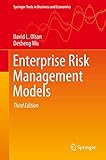Enterprise Risk Management Models [electronic resource] / by David L. Olson, Desheng Wu.
Material type: TextSeries: Springer Texts in Business and EconomicsPublisher: Berlin, Heidelberg : Springer Berlin Heidelberg : Imprint: Springer, 2020Edition: 3rd ed. 2020Description: IX, 225 p. 51 illus. online resourceContent type: text Media type: computer Carrier type: online resourceISBN: 9783662606087Subject(s): Risk management | Production management | Computer simulation | Risk Management | Operations Management | Simulation and ModelingAdditional physical formats: Printed edition:: No title; Printed edition:: No titleDDC classification: 658.155 LOC classification: HD61Online resources: Click here to access online
TextSeries: Springer Texts in Business and EconomicsPublisher: Berlin, Heidelberg : Springer Berlin Heidelberg : Imprint: Springer, 2020Edition: 3rd ed. 2020Description: IX, 225 p. 51 illus. online resourceContent type: text Media type: computer Carrier type: online resourceISBN: 9783662606087Subject(s): Risk management | Production management | Computer simulation | Risk Management | Operations Management | Simulation and ModelingAdditional physical formats: Printed edition:: No title; Printed edition:: No titleDDC classification: 658.155 LOC classification: HD61Online resources: Click here to access online Enterprise Risk Management in Supply Chains -- Risk Matrices -- Value-Focused Supply Chain Risk Analysis -- Examples of Supply Chain Decisions Trading Off Criteria -- Simulation of Supply Chain Risk -- Value at Risk Models -- Chance Constrained Models -- Data Envelopment Analysis in Enterprise Risk Management -- Data Mining Models and Enterprise Risk Management -- Balanced Scorecards to Measure Enterprise Risk Performance -- Information Systems Security Risk -- Enterprise Risk Management in Projects -- Natural Disaster Risk Management -- Sustainability and Enterprise Risk Management -- Environmental Damage and Risk Assessment.
This book offers a comprehensive guide to several aspects of risk, including information systems, disaster management, supply chain and disaster management perspectives. A major portion of the book is devoted to presenting a number of operations research models that have been (or could be) applied to enterprise supply risk management, especially from the supply chain perspective. Each chapter of this book can be used as a stand-alone module on a respective topic, with dedicated examples, definitions and discussion notes. This book comes at a time when the world is increasingly challenged by different forms of risk and how to manage them. Events of the 21st Century have made enterprise risk management even more critical. Risks such as suspicions surrounding top-management structures, financial and technology bubbles (especially since 2008), as well as the risk posed by terrorism, such as the 9/11 attacks in the U.S. as well as more recent events in France, Belgium, and other European countries, have a tremendous impact on many facets of business. Businesses, in fact, exist to cope with risk in their area of specialization.
